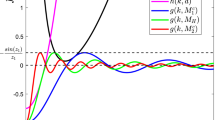Abstract
Continuous population distributions that undergo self-diffusion, migrational cross-diffusion and interaction in a region of (1-, 2- or 3-dimensional) space are described dynamically by a governing system of nonlinear reaction-diffusion equations. It is shown that the constants associated with migrational cross-diffusion are ordinarily nonnegative or nonpositive, contingent on the type of species interaction. A simple sign relationship obtains between the latter diffusivity constants and the rate constants for species interaction in the neighborhood of a spatially uniform equilibrium state, and this relationship of signs serves to simplify the general stability theory for the growth or decay of arbitrary perturbations on a spatially uniform equilibrium state. The stability of the equilibrium state is analyzed and discussed in detail for the case of a generic two-species model, where the self-diffusion and migrational cross-diffusion of species act to either stabilize or destabilize the equilibrium, depending essentially on the character of the species interaction and also on the magnitude of the Helmholtz eigenvalues associated with the region and boundary conditions. In particular, for a prey-predator or host-parasite model, self-diffusion usually helps to stabilize the equilibrium state and migrational cross-diffusion can only act as an additional stabilizing influence, as evidenced generally by the experiments on such two-species systems. Sufficient conditions are derived for stability of the equilibrium state in the general case for an arbitrarily large number of interacting species. It is shown that the equilibrium state is always stable if all species undergo significant self-diffusion and the Helmholtz eigenvalues are suitably large.
Similar content being viewed by others
Literature
Aris, R. 1975.The Mathematical Theory of Diffusion and Reaction in Permeable Catalysts, Vol. 2, pp. 120–126, London: Oxford University Press.
Bellman, R. 1970.Methods of Nonlinear Analysis, pp. 104–126. London: Academic Press.
Gause, G. F. 1934. “Experimental Analysis of Vito Volterra’s Mathematical Theory of the Struggle for Existence.”Science 79, 16–17.
— 1935. “Experimental Demonstration of Volterra’s Periodic Oscillations in Numbers of Animals.”J. Exp. Biol. 12, 44–48.
— 1936. “Further Studies of Interaction Between Predator and Prey.”J. Anim. Ecol. 5, 1–18.
Huffaker, C. B. 1958. “Experimental Studies on Predation: Dispersion Factors and Predator-Prey Oscillations.”Hilgardia 27, 305–329.
Huffaker, C. B., K. P. Shea and S. G. Herman. 1963. “Experimental Studies on Predation: Complex Dispersion and Levels of Food in an Acarine predator-Prey Interaction.”Hilgardia 37, 305–309.
Keller, E. F. and L. A. Segel. 1970. “Initiation of Slime Mold Aggregation Viewed as an Instability.”J. Theor. Biol. 26, 399–415.
Levin, S. A. 1975.Ecosystem Analysis and Prediction. Philadelphia SIAM Publications.
Luckinbill, L. S. 1973. “Coexistence in Laboratory Populations ofParamecium aurelia and its PredatorDidinium nasutum.”Ecology 54, 1320–1327.
Maynard Smith, J. 1974.Models in Ecology, pp. 33–35. Cambridge: Cambridge University Press.
McKenzie, L. 1966. “Matrices with Dominant Diagonals and Economic Theory.”Proc. Symp. Math. Methods Soc. Sci., pp. 47–62. Stanford: Stanford University Press.
Nicholson, A. J. 1933. “The Balance of Animal Populations.”J. Anim. Ecol. 2, 132–178.
Nicholson, A. J. and V. A. Bailey. 1935. “The Balance of Animal Populations.”Proc. Zool. Soc., Lond.3, 551–598.
Pimentel, D., W. P. Nagel and J. L. Madden. 1963. “Space-time Structure of the Environment and the Survival of Parasite-Host Systems.”Am. Natur. 97, 141–167.
Rosen, G. 1974. “Global Theorems for Species Distributions Governed by Reaction-Diffusion Equations.”J. Chem. Phys. 61, 3676–3679.
Rosen, G. and R. G. Fizell. 1975. “Bounds on the Total Population for Species Governed by Reaction-Diffusion Equations in Arbitrary Regions.”Bull. Math. Biol. 37, 71–78.
Tanner, J. T. 1966. “Effects of Population Density on Growth Rates of Animal Populations.”Ecology 47, 733–745.
Author information
Authors and Affiliations
Rights and permissions
About this article
Cite this article
Rosen, G. Effects of diffusion on the stability of the equilibrium in multi-species ecological systems. Bltn Mathcal Biology 39, 373–383 (1977). https://doi.org/10.1007/BF02462916
Received:
Revised:
Issue Date:
DOI: https://doi.org/10.1007/BF02462916




